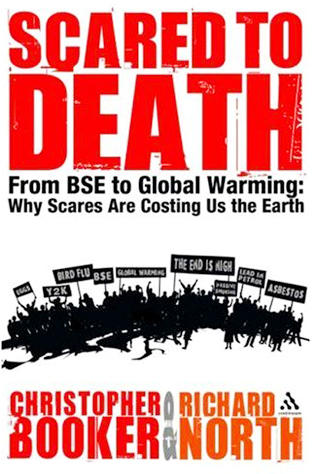As claims go, the suggestion that the entire solar system is warming intensely is a corker. Mars and Pluto are heating up like Earth, it is alleged - disturbing news that appears in Christopher Booker and Richard North's examination of scare stories and "the new age of superstition" in which, it is alleged, we live.
Indeed, astronomers have known for years that temperatures are rising on our sister planets but have failed to pass on the news, we are told. This is a cosmic conspiracy - for if Jupiter and Triton are heating up, then the cause cannot be human. Our polluting influence does not extend to the solar system's perimeter. Only the sun has that kind of impact. So forget carbon emissions. Blame rising solar radiation for all global warming.
This sounds powerful stuff, though we should take care. Booker and North are committed climate-change deniers whose astronomical claims appear in a lengthy chapter dedicated to debunking any idea that Earth is overheating because of mankind's carbon dioxide emissions. Thus the revelation that global warming is an interplanetary problem, not a local one, comes from those with most to gain from the idea and provides convenient support for their campaign to ensure that gas-guzzling, coal-burning and international air flights remain inalienable human rights.

But are they correct? Can we really blame solar radiation for all global warming? The authors outline six sources and then wrap up their argument with quotes from a scientist whose solar research they clearly feel is unimpeachable. First, those sources: items from ABC News, USA Today, National Geographic, an MIT press release and links to Web sites of NASA and a media group, Space.com. None is a primary source. All are interpretations, by others, of astronomical research. They share a common thread, however: that unexpected warming has been detected on Neptune's moon Triton, on Jupiter, on Pluto and on Mars' shrinking southern ice cap.
This, then, is the conclusive proof that planetary heating is "taking place throughout the solar system." In fact, it is merely an example of scientific cherry-picking. All planets have seasons and there is no reason to believe that these case studies are anything other than instances of this phenomenon. "Any moon or planet with an atmosphere will experience temperature fluctuations. There is no evidence these examples are anything other than those caused by seasonal variations," says Professor Carl Murray of Queen Mary College, London. "These people have added two and two and got five."
This point is supported by Murray's colleague, atmosphere physicist James Cho: "These references are very selective and misrepresentative," he says, a view that is also backed by Oxford Professor Peter Read, who has worked on several robot missions to Mars. "Take the melting of the ice cap on Mars' south pole. There is no evidence of warming happening elsewhere on the planet. The effect is most probably some local climatic phenomenon. So is the solar system in the grip of global warming? No, it isn't."
And then there is that final interview - with Cambridge astrophysicist Nigel Weiss - that is sourced to Canada's Financial Post. He is said to support solar radiation changes as the cause of Earth's woes and believes things will soon get cool again once the sun mends its ways. Direct quotes from Weiss are included.
Except that Weiss never said any such thing. He never even gave an interview to the Post, which long ago posted a retraction and an apology, under legal threat from Weiss who was infuriated such claims had been falsely attributed to him. "I don't believe solar radiation is the main cause of global warming and I never said so to the Post, as the authors of this book would have discovered if they had asked me," says Weiss.
This is not the time to go into the Post's motive for attributing such views to Weiss. Suffice to say, it has its own climate-change denial agenda. Not that this has bothered Booker and North. Self-appointed judges of their profession, according to the rest of Scared to Death, they have constructed, utterly without shame, a quite preposterous theory by throwing together a few clippings, making no discernible fact checks and reporting a non-existent interview. They accuse other journalists of "unthinking credulity" but commit egregious errors that would shame a junior reporter.
Then there is this year's Royal Society report by physicists Mike Lockwood and Claus Frohlich, who surveyed radiation records for the past 40 years and who concluded, unambiguously, "that the observed rapid rise in global mean temperatures seen after 1985 cannot be ascribed to solar variability." Incredibly, this is dismissed by the authors because of its careful selection of evidence.
This interplanetary scare story is only one Booker and North bete noir, of course. They also allege passive smoking is safe, speed cameras cost lives, and bovine spongiform encephalopathy, commonly known as mad cow disease was never a threat to health. Individuals who disagree are simply scaremongers. Again, most of the evidence is flaky. Going back to their major bogey, climate change, Booker and North claim a US National Academy report in 2000 concluded Earth's lower atmosphere, the troposphere, had cooled between 1980 and 2000. It didn't. It showed a warming. Similarly, they say the "hockey stick" graph commonly used to show Earth's rapidly rising temperatures has been discredited and dropped from the Intergovernmental Panel on Climate Change's last assessment report. In fact, it appears on page 467.
In some ways, it is hard to credit such sloppiness and partiality, though I don't believe for a minute the authors seek to delude readers. The delusion lies within. No nanny state is going to control their lives, limit their car-traveling, stop them driving fast or make them recycle their trash. If research backs such restrictions, then it must be wrong and by carefully selecting sources, a demolition of mainstream science can be given precarious credibility. The result is misguided and sad.

Cheng Ching-hsiang (鄭青祥) turned a small triangle of concrete jammed between two old shops into a cool little bar called 9dimension. In front of the shop, a steampunk-like structure was welded by himself to serve as a booth where he prepares cocktails. “Yancheng used to be just old people,” he says, “but now young people are coming and creating the New Yancheng.” Around the corner, Yu Hsiu-jao (饒毓琇), opened Tiny Cafe. True to its name, it is the size of a cupboard and serves cold-brewed coffee. “Small shops are so special and have personality,” she says, “people come to Yancheng to find such treasures.” She

The low voter turnout for the referendum on Aug. 23 shows that many Taiwanese are apathetic about nuclear energy, but there are long-term energy stakes involved that the public needs to grasp Taiwan faces an energy trilemma: soaring AI-driven demand, pressure to cut carbon and reliance on fragile fuel imports. But the nuclear referendum on Aug. 23 showed how little this registered with voters, many of whom neither see the long game nor grasp the stakes. Volunteer referendum worker Vivian Chen (陳薇安) put it bluntly: “I’ve seen many people asking what they’re voting for when they arrive to vote. They cast their vote without even doing any research.” Imagine Taiwanese voters invited to a poker table. The bet looked simple — yes or no — yet most never showed. More than two-thirds of those

In the run-up to the referendum on re-opening Pingtung County’s Ma-anshan Nuclear Power Plant last month, the media inundated us with explainers. A favorite factoid of the international media, endlessly recycled, was that Taiwan has no energy reserves for a blockade, thus necessitating re-opening the nuclear plants. As presented by the Chinese-language CommonWealth Magazine, it runs: “According to the US Department of Commerce International Trade Administration, 97.73 percent of Taiwan’s energy is imported, and estimates are that Taiwan has only 11 days of reserves available in the event of a blockade.” This factoid is not an outright lie — that

In July of 1995, a group of local DJs began posting an event flyer around Taipei. It was cheaply photocopied and nearly all in English, with a hand-drawn map on the back and, on the front, a big red hand print alongside one prominent line of text, “Finally… THE PARTY.” The map led to a remote floodplain in Taipei County (now New Taipei City) just across the Tamsui River from Taipei. The organizers got permission from no one. They just drove up in a blue Taiwanese pickup truck, set up a generator, two speakers, two turntables and a mixer. They